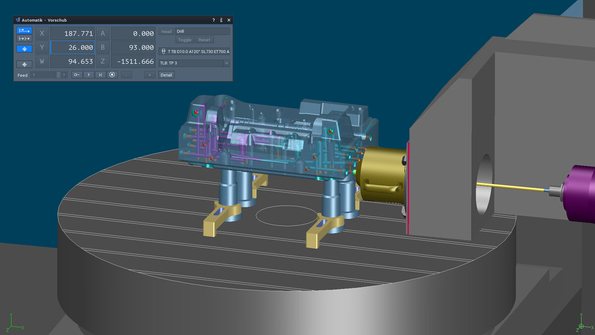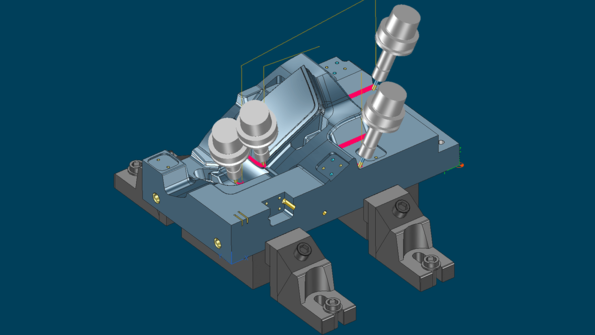Tebis launches Version 4.0 Release 8
Martinsried, Germany, December 4, 2019 – Tebis, a specialist in CAD/CAM and MES process solutions in model, die and mold manufacturing, is launching Version 4.0 Release 8 of its CAD/CAM software. The many features and improvements are all designed to help companies implement their manufacturing projects reliably, efficiently and with no collisions.
Highlights include indexed collision avoidance, a simplified feature scanner, improved 5-axis simultaneous avoidance milling and much more. Reverse engineering is also easier and faster with more automation. Tebis 4.0 Release 8 will be launched in the first half of December.
The most important features of Release 8 at a glance:
- CAD – Reverse engineering
More automation and clear presentation of the results
A wire-frame model is the basis for reverse engineering; it’s created from digitized data, which in turn is used to create a surface model. With the new Tebis Version 4.0 Release 8, wire-frame models can now be automatically smoothed and the surface model can be generated automatically and efficiently. Designed curves that are not to be changed during surface creation can also be fixed accordingly. The surface model can be automatically calculated for the entire wire-frame model. This now generates many surfaces in a single step that the user previously had to create individually.
- CAM – Drilling
Extended unit library enables complete automation of deep-hole drilling
The new release also provides variable drill bushes and drill bush holders as machine components in the unit library. This means that all components of state-of-the-art deep-hole drilling machines can now be stored in the system as digital twins. Based on this, users can generate their NC programs for 5-sided deep-hole drilling operations highly automatically and with no restrictions.
- CAM – Automation
Better overview and clear operating structures in the revised feature scanner
The revised feature scanner scans the part completely and without interruption for holes and pockets. Clearly detectable features are automatically applied. If several different features are possible for a geometry, users can click on the relevant areas after scanning and select the desired feature. Another plus for convenience: Geometry for which features are already linked to the part – for example, because they were imported via interfaces or because the part was already scanned at an earlier time – is accounted for during scanning and is skipped.
- CAM milling
Faster machining with indexed collision avoidance
With indexed tilt direction determination, Release 8 offers a new and very convenient strategy for collision avoidance in the area of residual stock machining: The entire part is automatically divided into different milling areas, each of which can be manufactured at the same tilt direction with no collisions. The result is a complete program for the overall part with several different tilt directions. Indexed collision avoidance therefore shortens machining time and improves surface quality. It is recommended, for example, for multi-axis machines that are unsuitable for 5-axis simultaneous machining because of their dynamics.
High-performance roughing with optimized connecting paths.
The new "re-roughing mode" in Release 8 accelerates roughing and ensures a longer tool life. Users can now proactively select ramp downfeed on short paths between machining planes. If desired, the connection length above which downfeed is executed at rapid traverse rate via a retract height can also be specified.
Shorter run times and fewer machine movements in 5-axis simultaneous avoidance milling
The function for 5-axis simultaneous avoidance milling has been improved comprehensively. Specific milling areas that can’t be machined collision-free in a project calculated with the collision avoidance strategy are automatically deactivated. The pivoting behavior of the tool has also been optimized. The tool doesn’t perform 5-axis simultaneous avoidance unless a collision would actually occur in 3-axis machining.
5-axis simultaneous deburring, now also with tapered cutters
Edges that don’t lie in the same plane in space can now also be processed by automatic multi-axis simultaneous deburring with tapered cutters in the new Release 8. Users can also specifically select whether to machine the part in climb cut, conventional cut or lace cut mode. Machining of sharp edges and corners has also been optimized.
Tebis has prepared a three-part webinar series in addition to the introduction of Version 4.0 Release 8. In these webinars, Product Managers Franziska Siegrist and Fabian Jud present the features and improvements in the new release and explain specific advantages. The (free) webinars, "Overview of all new features“ (November 29), "News from the CAD world" (December 6) and "Top CAM highlights" (December 13) are 45 minutes each and will also be available for later viewing online. More information and a registration form are provided here: Webinars




